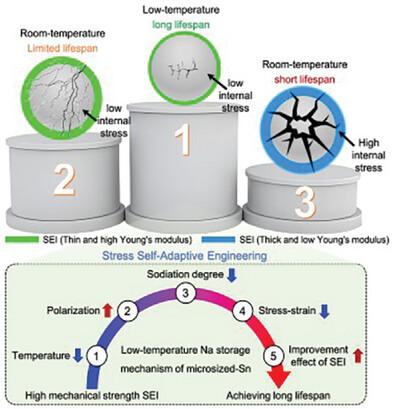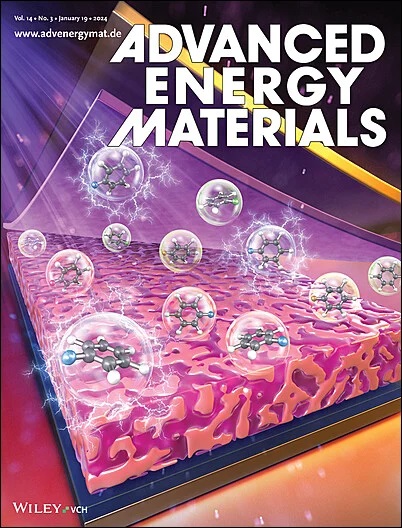Stress Self-Adaptive Engineering Advances the Low-Temperature Na Storage Cycling Stability of Microsized Sn
IF 24.4
1区 材料科学
Q1 CHEMISTRY, PHYSICAL
引用次数: 0
Abstract
Microsized Sn (μ-Sn) is a promising anode material for sodium-ion batteries that has a high theoretical capacity of 847 mAh g−1 and demonstrates a phase transition from β-Sn to α-Sn below 13 °C, enabling faster ion transport at low-temperatures. However, it faces challenges such as considerable volume expansion during cycling, unstable solid electrolyte interphase (SEI) formation, and an absence of effective regulation methods. Herein, a “killing three birds with one stone” strategy leveraging stress self-adaptive engineering is proposed to achieve low-temperature cycling stability in μ-Sn. At the expense of a partially reversible capacity, lowering the temperature increases the polarization voltage of μ-Sn during sodiation, resulting in a lower sodiation degree and the formation of dispersed amorphous products, thereby reducing the volume change. This relatively small volume expansion, compared to that at room temperature, is mitigated by the high-mechanical-strength SEI formed by the preferred low-temperature-resistant electrolyte, suppressing chemomechanical degradation and enhancing low-temperature cycling stability. The μ-Sn exhibits a high specific capacity of 680.9 mAh g−1 after 150 cycles at −30 °C, which is 6.6 times higher than that at 25 °C. This work demonstrates a simple and effective approach for obtaining safe and high-performance sodium-ion batteries across broad temperature ranges.

求助全文
约1分钟内获得全文
求助全文
来源期刊

Advanced Energy Materials
CHEMISTRY, PHYSICAL-ENERGY & FUELS
CiteScore
41.90
自引率
4.00%
发文量
889
审稿时长
1.4 months
期刊介绍:
Established in 2011, Advanced Energy Materials is an international, interdisciplinary, English-language journal that focuses on materials used in energy harvesting, conversion, and storage. It is regarded as a top-quality journal alongside Advanced Materials, Advanced Functional Materials, and Small.
With a 2022 Impact Factor of 27.8, Advanced Energy Materials is considered a prime source for the best energy-related research. The journal covers a wide range of topics in energy-related research, including organic and inorganic photovoltaics, batteries and supercapacitors, fuel cells, hydrogen generation and storage, thermoelectrics, water splitting and photocatalysis, solar fuels and thermosolar power, magnetocalorics, and piezoelectronics.
The readership of Advanced Energy Materials includes materials scientists, chemists, physicists, and engineers in both academia and industry. The journal is indexed in various databases and collections, such as Advanced Technologies & Aerospace Database, FIZ Karlsruhe, INSPEC (IET), Science Citation Index Expanded, Technology Collection, and Web of Science, among others.
 求助内容:
求助内容: 应助结果提醒方式:
应助结果提醒方式:


